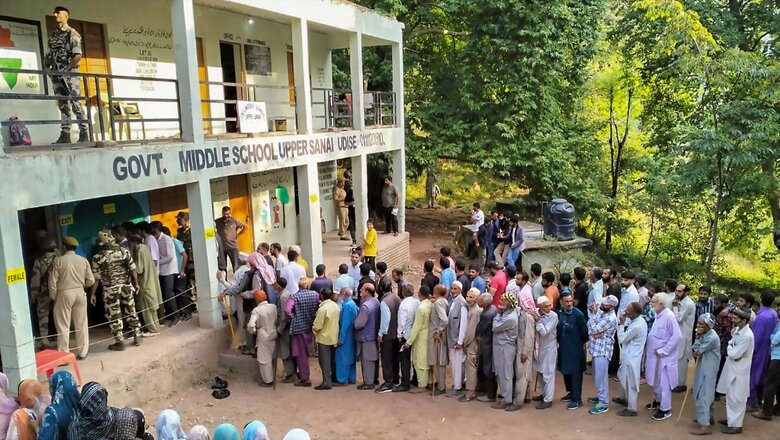
views
Prime Minister Narendra Modi’s brand of inclusive politics is redefining welfarism in Jammu & Kashmir. Not only are elections being held in a free and fair manner but have been peaceful, with foreign observers getting to witness India’s transparent electoral process under the aegis of PM Modi’s leadership. More than 2.5 million voters decided the fate of 239 candidates, including 79 in the Pir Panjal region of Jammu during the second phase of elections on September 25, 2024, which recorded voter turnout of over 57 per cent.
There were 3,502 polling stations and no polling booth had a voting percentage in single digits. In Srinagar, the polling percentage exceeded the Lok Sabha 2024 figures by over 5 per cent. According to the EC’s data on poll turnout, Reasi district recorded the highest voting percentage of 74.14 per cent followed by Poonch (73.78 per cent), Rajouri (69.85 per cent), Budgam (61.31 per cent), Ganderbal (62.63 per cent) and Srinagar (29.24 per cent). Srinagar has shown an increase compared to the 2014 Assembly election when it recorded a 27 per cent voter turnout.
“These elections are history in the making, the echoes of which will be carried through posterity. The valleys and the mountains, which had once witnessed fear and boycott, are now taking part in the democratic festivities, or Jashn-e-Jamhuriat,” Chief Election Commissioner (CEC) Rajiv Kumar said.
This is the first assembly election being held in Jammu and Kashmir in 10 years and also the first after the abrogation of Article 370. The third phase will take place on October 1, 2024, after which counting of votes will be held on October 8, 2024.
The first phase of elections on September 18, 2024, recorded a voter turnout of 61.13 per cent, which was held in 24 constituencies in seven districts. At least 157 special polling stations have been established including 26 “pink polling stations” headed by women, 26 polling stations managed by specially-abled persons, 26 polling stations held by youths, 31 border polling stations, 26 green polling stations and 22 unique polling stat. Foreign delegates visited a floating polling booth on Dal Lake in Srinagar during the second phase of Jammu and Kashmir elections. Norwegian diplomat Beate Gabrielsen expressed her appreciation for her visit to Srinagar, saying, “It’s good and I’ve never been here before. It’s good to come to Srinagar.” She visited a polling booth during the second phase of polling for the Jammu & Kashmir elections.
The three districts of Rajouri, Poonch and Reasi, closer to the Line of Control (LoC) and a hub for terror attacks this year, saw long queues outside polling stations. “I voted to safeguard my country’s interest,” Nitu Mia, a transgender voter from the Reasi segment said. In the Kashmir valley, there were long queues outside the polling booths in Budgam and Ganderbal. To ensure “no voter is left behind” in Jammu and Kashmir, the Election Commission set up three floating polling stations on the Dal Lake and one along the LoC to “exclusively” serve an area that has 100 per cent ST population.
For the three floating polling stations on the Dal Lake, the polling teams have been taken on ferries and shikaras. One of the three polling stations, Khar Mohalla Aabi Karpora, has only three voters. The Koragbal polling station in the Gurez assembly constituency is situated along the Line of Control (LoC). It exclusively serves a 100 per cent Scheduled Tribe (ST) population. In the Lok Sabha elections, this polling station had recorded a voter turnout of 80.01 per cent. Again, Seemari is the first polling station in Kupwara district. It consistently achieves high voter turnout despite logistical and security challenges. The moot point is this: A vibrant democracy and free and fair elections under the Modi government are rapidly enhancing India’s rising strength in the comity of nations.
After the abrogation of Article 370, various public outreach measures were undertaken. For decades, the Abdullahs and the Muftis treated this region as their personal fiefdom.
In 2015, while announcing the ambitious Rs 80,000-crore development package for Jammu and Kashmir, from the Sher-e-Kashmir cricket stadium in Srinagar, PM Modi made a passionate mention of “Kashmiriyat, Jamhooriyat and Insaniyat” (Kashmiri culture, democracy, and humanity). “Kashmiriyat ke bina Hindustan adhura hai,” said Modi (without Kashmiriyat, India is incomplete). The mega package that was to change the face of the terror-hit region and draw the disillusioned back into the mainstream, has been a resounding success. On the jobs’ front, thousands of jobs were created for Kashmiri migrants in the last few years. Financial assistance of Rs 578 crore through Direct Benefit Transfer (DBT) was provided to 12,588 displaced families (of the 36,384 families) from Pakistan-occupied Kashmir and Chhamb. Land was acquired for an IIT and an IIM in Jammu and for the two AIIMS in Jammu and Awantipora in Kashmir. Power projects have moved at a fast pace. The Pakal Dul 1,000 MW project and the Srinagar-Leh transmission line are on course. Of the 28 small hydropower projects estimated to cost a total of Rs 2,000 crore, a number of projects have either already kicked off the ground or will do so, soon enough.
The Rs 80,000 crore package consists of 63 major development projects being implemented by 15 Central Ministries. The Chenani-Nashri tunnel, also known as the Patni-top or Syama Prasad Mookerjee tunnel, is not only India’s longest highway tunnel, but also Asia’s longest bi-directional highway tunnel. The tunnel stretching 9.28 km, that was inaugurated by PM Modi in April 2017, is a huge achievement that is set to transform how different regions of India are connected across various terrains. The tunnel has reduced travel time between Jammu and Srinagar by two to four hours, reducing the distance by 31 km, which in turn has resulted in a huge reduction in consumption of fuel. The Modi government estimates a reduction of Rs 27 lakh of fuel consumption per day, on average. Further, the tunnel is impervious to natural calamities such as landslides and avalanches which are common in the region. The core advantage the tunnel offers is permanent connectivity to the Kashmir valley, which was hitherto only intermittently connected.
The fact that Jammu and Kashmir has always been high on the Modi government’s priority list is best amplified by PM Modi’s launch of the Social Endeavour for Health and Telemedicine (SEHAT) scheme on December 26, 2020. The scheme will cover the remaining one crore population which has not been covered under the Ayushman Bharat Scheme. With the launch of the Sehat scheme, Jammu and Kashmir is among the first in India to achieve universal health coverage. Currently, under the Ayushman Bharat PM Jan Arogya Yojana (AB-PMJAY), which gives eligible beneficiaries a free health cover of Rs. 5 lakh, over 30 lakh people are already covered in Jammu and Kashmir.
An uneasy calm that had prevailed in the valley after the revocation of Articles 370 and 35-A, has now paved the way for higher business confidence and greater stability, with terrorism and separatism taking a backseat. Abrogation of Articles 370 and 35-A have made it possible to implement the 7th pay commission recommendations and the Indian Penal Code (IPC), rather than the Ranbir Penal Code (RPC), which was in vogue all these years. Under Article 35-A, no outsider could bag a government job. Earlier, companies were forced to hire only locals.
Revocation of the above Articles has levelled the playing field in Jammu and Kashmir. No investor was willing to set up an industry, hotel, private educational institution or private hospital, since he or she could neither buy land or property. Their wards could not get government jobs or admission to colleges. In so many decades, there are barely any major national or international chains which have set up hotels in a tourism-centric region like J&K, preventing enrichment, resource generation and job creation. But on August 5, 2019, Prime Minister Modi’s government, reset the clock, undoing all the misguided wrongs of the jaded Nehruvian era, in an unprecedented, epoch-making decision of abrogating Articles 370 and 35-A. The rest is history, as they say.
In a Clubhouse discussion few years ago, senior Congress leader and former Madhya Pradesh CM Digvijay Singh, notorious for being a loose cannon, said that the Congress would consider restoring Article 370 if it came to power, forgetting that the revocation of the said Article is full and final and cannot be undone.
Coming back to the issue of free and fair elections in Jammu and Kashmir, let us turn back the clock to 1987. News reports then were full of eyewitnesses speaking of a pattern of “rigging and strong-arm tactics all over the valley”, of “massive booth-capturing by gangs”, of “entire ballot-boxes pre-stamped in favour of the National Conference”, of numerous people “simply not being allowed to vote”, and of government supervisors “stopping the counting as soon as they saw opposition candidates taking a lead”, as per Sumantra Bose in his book, Kashmir: Roots of Conflict, Path to Peace.
In 1987, reports of electoral rigging poured into several offices of District Commissioners from various parts of the Valley. In Pattan, for instance, entire ballot books pre-stamped for the National Conference (bearing serial numbers 024864-024898) were recovered with counterfoils intact from polling booths, according to a report by journalist Inderjit Bhadwar. Similar pre-stamped books were found from polling officers at Idgah, Handwara and Cahdura, according to the report. Booth-capturing at Khan Sahib and Hazratbal where gangs of National Conference (NC) workers drove to polling stations in Matador vans and entered the booths while the police looked helplessly on, are still fresh in the memories of those who witnessed democracy being trampled in 1987 under the then Prime Minister, Rajiv Gandhi, and the likes of Farooq Abdullah. In several counting stations in 1987, the counting process was stopped when MUF candidates took the lead over Congress-NC candidates.
As a result, the polls were swept by the alliance of Farooq Abdullah’s Jammu and Kashmir National Conference and Congress, led by the then PM, Rajiv Gandhi. While the Congress won all 26 seats it contested, the NC was declared winner in 40 of the 46 seats it contested. As a documented report says, “The belief that Rajiv Gandhi’s government had left the Kashmiri Muslim population in 1987 electorally disenfranchised” was one of the factors behind the conflict in Kashmir. The blatant poll manipulations of 1987 were among the several factors, including those fanned by Pakistan and its spy agency ISI, that led to widespread anger in Jammu and Kashmir and resulted in the rise of militancy and terrorism in the Valley by 1989.
The contrast between 1987 and 2024 is sharp and stark. In 1987, the Congress and the National Conference undermined the very ethos of India’s democratic institutions, via mass rigging. However, thanks to Prime Minister Modi’s unflinching commitment to democratic values and ideals, in 2024, the elections in Jammu & Kashmir, under the glare of foreign observers, is a glowing testament to how the Modi government continues to uphold the highest traditions of electoral democracy with fervour, but without fear or favour.
Sanju Verma is an economist, national spokesperson for the BJP and the bestselling Author of ‘The Modi Gambit’. Views expressed in the above piece are personal and solely those of the author. They do not necessarily reflect News18’s views.
















Comments
0 comment